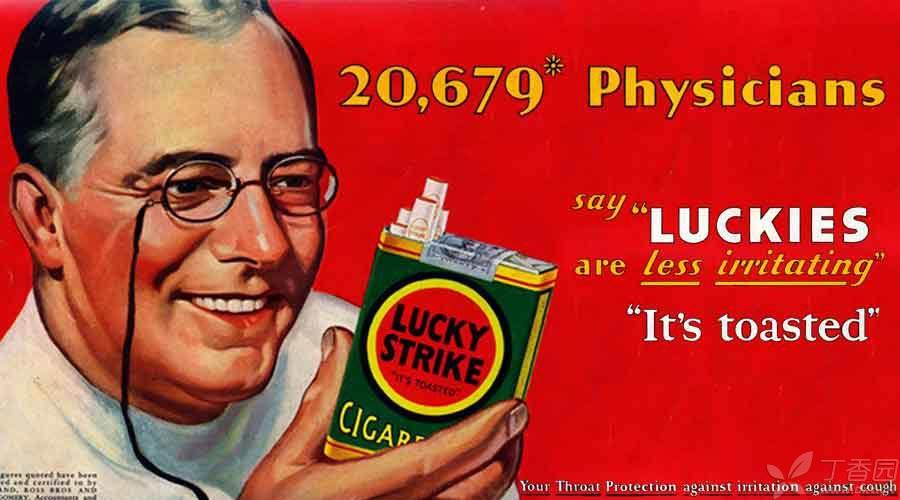
It is now a well-known fact that smoking is harmful to health.
But do you know that there was a time when tobacco was marketed as a health product. And these marketing methods are still popular in many products today and are not uncommon.
Speaking, the habit of smoking in the United States did not come into being until the 20th century. Although tobacco originated in the American continent, in the 19th century, Americans mainly chewed tobacco. Moreover, they chewed it in public places, streets, theatres and hotels without scruple. After chewing tobacco, they vomited everywhere to show the democracy and freedom of the United States.
The habit of smoking, It is said that during the Crimean War in 1856, The British brought it back from the Near East. But [rumors] say it’s not good for the lungs. The taste is too strong, So it has not been accepted by the public. Even dropped the ugly nickname [coffin nail]. In the 1880s, Smoking is mostly forbidden in public places such as banks and offices, and only tasteful cigars can be smoked. However, since the invention of automatic cigarette making machines in 1885, the production efficiency of cigarettes has greatly increased. A few years later, American tobacco companies discovered that their cigarettes have far exceeded the needs of the market.
At this time, I happened to chew tobacco. For health reasons, Began to be abandoned by the public. Originally, the medical profession believed that chewing tobacco gave birth to the habit of spitting in the United States, making many infectious diseases, especially tuberculosis, easier to spread. As a result, in big cities, reformers launched a public health campaign and spittoons began to become popular. Americans who felt inconvenient slowly turned to smoking.
In order to sell cigarettes, Various marketing methods have been invented. For example, star cards, which are now common things, In order to attract women to smoke, marketing guru Edward Bernays even created the slogan “Freedom Torch” to describe tobacco, comparing smoking with women’s liberation. This method of using doctors to sell cigarettes is also a tactic devised by tobacco companies.
It turns out that at the beginning of the 20th century, The link between smoking and disease is unclear, Statistical methods are also immature, There is no scientific and systematic method to assess the harm of tobacco. Since the harm of smoking to people needs to accumulate slowly before it is gradually manifested, Most doctors cannot understand the complicated relationship. In 1954, An article in the New England Journal of Medicine conducted a survey of more than 4,000 doctors. Only one-third of the doctors found that they did not smoke. Half of these non-smoking doctors quit smoking later. For tobacco companies, this is an excellent opportunity: any doubt about the harm of tobacco can be countered by doctors smoking themselves. Do you still fear that the public will not believe such authoritative opinions?
The first person to try this method, Is the leader of the American tobacco industry, American Tobaco). In 1930, American Tobacco Company has launched a new tobacco advertisement. To promote their new brand Lucky Strike. The advertisement reads in large letters [20,679 doctors said “LUCKIES has less tingling sensation”]. Because many people have scruples about tobacco, that is, the irritation of smoking to the throat makes people uncomfortable. In order to show the superiority of their cigarettes, American tobacco companies have come up with such a big trick: a doctor’s opinion poll.
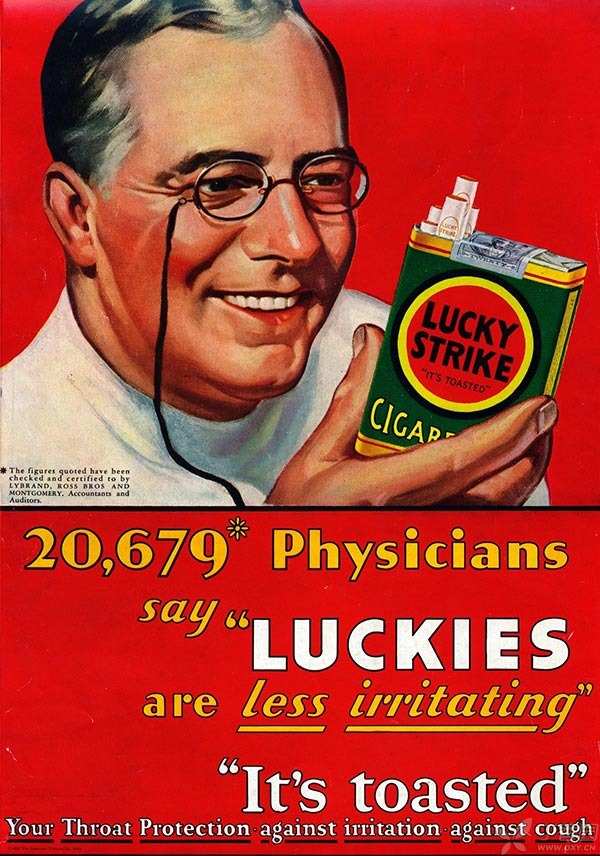
Lucky Strike’s doctor opinion survey, of course, was not the result of research by a third-party organization in what, but was completed by its advertising agency. The method was to send several cigarettes of their own to a large number of doctors between 1926 and 1928, accompanied by a questionnaire: “Is Lucky Strike cigarettes less irritating than other cigarettes for sensitive and thin throats? ]
Yes, this is how the investigation results [bribed] came out. Of course, the results have no credibility at all. And this tactic was later proved to be tried and tested.
Soon, Philips Morris, the well-known producer of Marlboro, as a latecomer to the tobacco industry, resorted to another extraordinary move in order to catch up, that is, to subsidize doctors to carry out research and publish research results that are beneficial to him.
When Philips Morris added a new ingredient to his cigarette paper, Diethylene glycol. In order to prove the superiority of his cigarettes, Philip Morris asked two scientists from Columbia University to do the research. They injected diethylene glycol into the eyes of rabbits to do the experiment. To show that diethylene glycol is less irritant than other cigarettes (but diethylene glycol is actually toxic, which is not difficult to imagine, and other scientists have great objection to this research). With such a officially published academic article, Philips Morris can use the word “clinical proof” in advertisements to publicize his superiority.
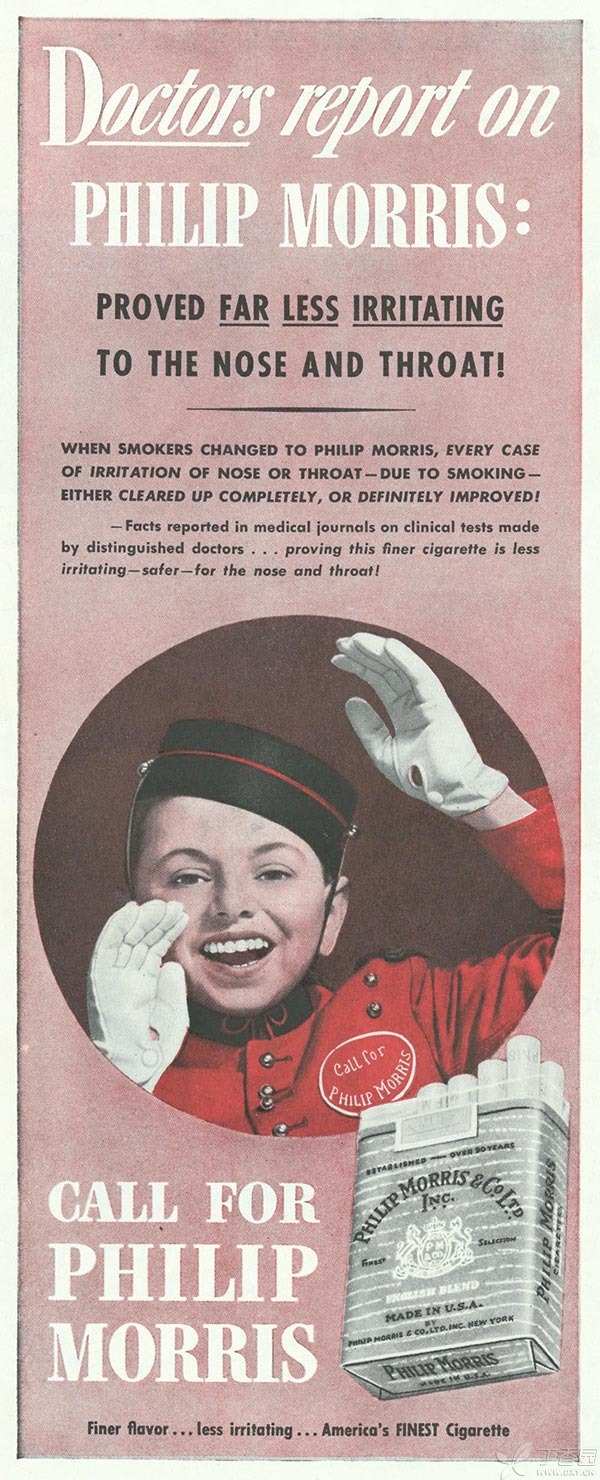
Philips Morris not only advertises in the mass media, It also advertises in medical journals. This is equivalent to supporting the publication of medical journals through advertising fees. It also appears at various medical conferences, distributes publicity materials and free cigarettes, and provides special lounges for doctors so that they can relax, smoke and chat, thus gaining the favor of the medical community.
With this series of marketing activities, Philip Morris successfully rose to become a giant in the US tobacco industry.
The success of the American Tobacco Company and Philip Morris led other tobacco companies to rush to the battlefield and began to win the support of doctors for their tobacco brands. By the 1947 annual meeting of the American Medical Association, some people said that they had seen hundreds of doctors lining up to receive free cigarettes from tobacco companies.
Soon, another tobacco giant, Reynolds, came up with a new idea.
Reynolds follows Philip Morris, A medical public relations department has been set up, It specializes in marketing through doctors and medical [discoveries]. It has been systematically advertising in medical journals since 1942. Unlike Philip Morris, Reynolds’s research direction is nicotine absorption. Reynolds’ [Camel] brand cigarettes are slow-burning cigarettes that light longer than other brands. So Reynolds called a doctor to prove that his slow-burning cigarettes can reduce nicotine absorption. Reynolds also took the opportunity of sending cigarettes to doctors to distribute relevant [research] information and hoped to reach smokers’ ears through the doctor’s mouth.
Not content to prove yourself only from a medical point of view, In 1946, Reynolds launched the “More Doctors” campaign, following the example of the American Tobacco Company in that year and using the results of the survey of doctors to publicize itself. Reynolds surveyed 113,597 doctors with the method of sending cigarettes for questionnaires very similar to that of the American Tobacco Company, and thus put forward the slogan: “Camel cigarettes are the most popular among doctors.”
Reynolds was not content to just cite some data in a boring way. He began to promote himself as a real doctor and put advertisements in popular publications such as Time. In this advertisement, the old smoker is Dr. Robert Jackler, director of otolaryngology at Stanford University School of Medicine.
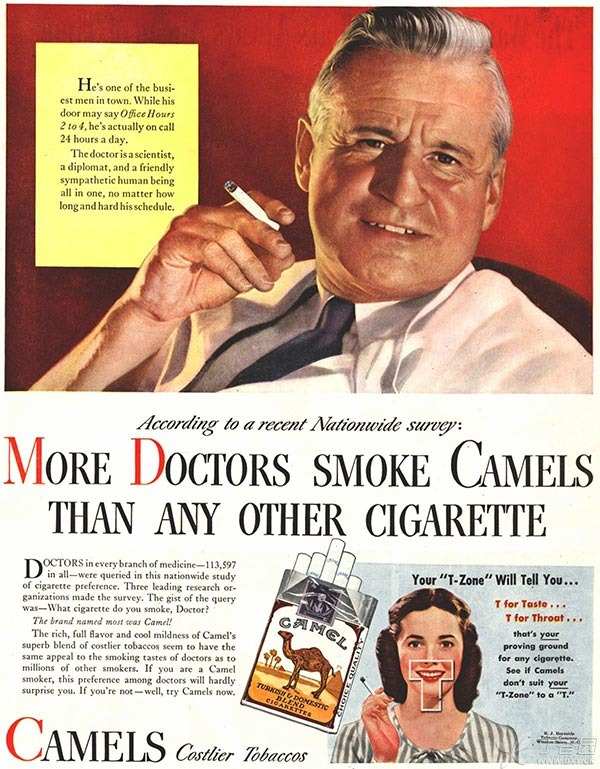
Jackler later said, Because in these advertisements, The images of doctors have been created to be extremely wise, So there is no objection from the medical profession at all. In many advertisements, There is also an advertisement praising the progress of medicine, saying that thanks to the efforts of doctors, the life span of human beings has greatly increased, [I can live to be 100 years old]. It juxtaposes the progress of medicine with the smoking of doctors to suggest that smoking is good for health.
In 1949, Reynolds is obviously a little bolder. This time its theme is [No Stimulation]. If the 1930 American tobacco advertisement only claimed that it was less stimulating to the throat than other cigarettes, This time Reynolds simply claimed that the scientific examination by laryngologists proved that [camel] cigarettes were not stimulating at all. Reynolds even took advantage of the public’s psychology of not trying or knowing, and typed [test by himself! ] slogan, calling on everyone to compare, invalid refund, just like cigarettes into throat candy.
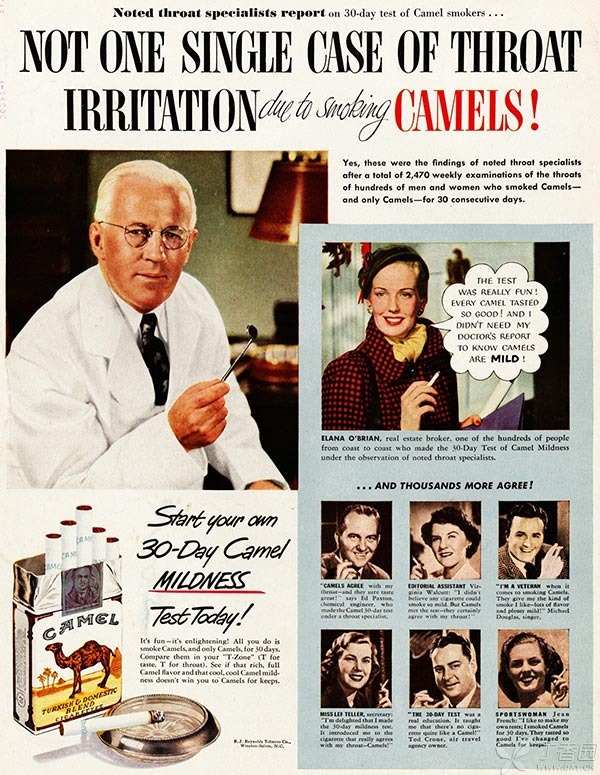
Advertisements of other companies are naturally unwilling to lose their strength, and the advertising war is menacing.
The doctor’s image in Chestfiled’s cigarette:
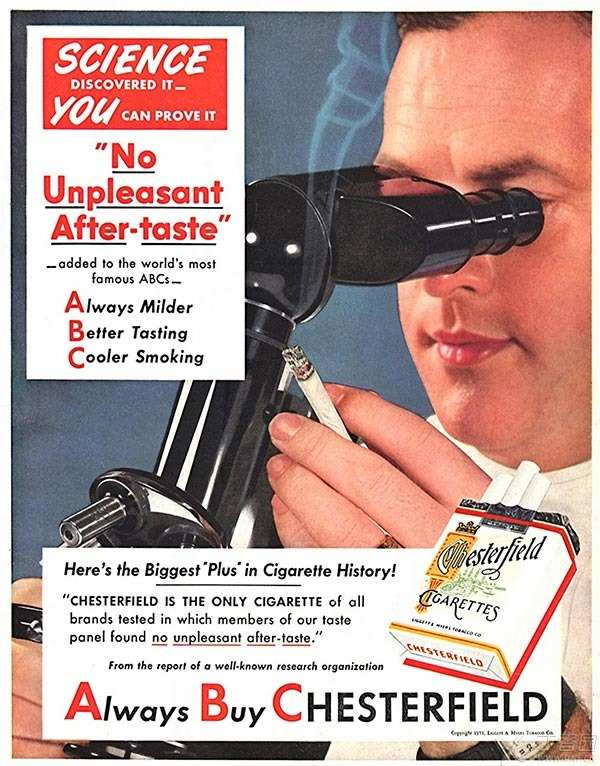
However, the good times did not last long. In 1950, Evars Graham and Ernst Wynder’s historic article on cigarette carcinogenesis was published in the Journal of the American Medical Association. In 1953, Their follow-up research confirms their previous findings, The idea that cigarettes cause cancer, It began to be widely accepted by doctors. Although the American Medical Association will not publicly admit that tobacco is harmful to health until 25 years later, it immediately decided not to accept any advertisements from tobacco companies in that year and publicly opposed tobacco companies to advertise in the name of doctors and the American Medical Association the following year, 1954. American doctors themselves began to quit smoking.
Five years later, less than 40% of doctors smoke.
Also in the same year, American tobacco companies held a meeting and invited Hill & Knowlton, a well-known public relations company, to study this issue. Hill & Knowlton suggested that all tobacco companies immediately withdraw from the advertising market and no longer mention any health guarantee. In 1954, almost instantly, doctors and their [research results] in American tobacco advertisements disappeared into thin air.
Although cigarette companies withdrew, the marketing methods they developed were carried forward by other companies with similar needs, such as health products and health foods.
This article is exclusively authorized by the author to be used by Clove Garden and refuses any other form of reprinting.
